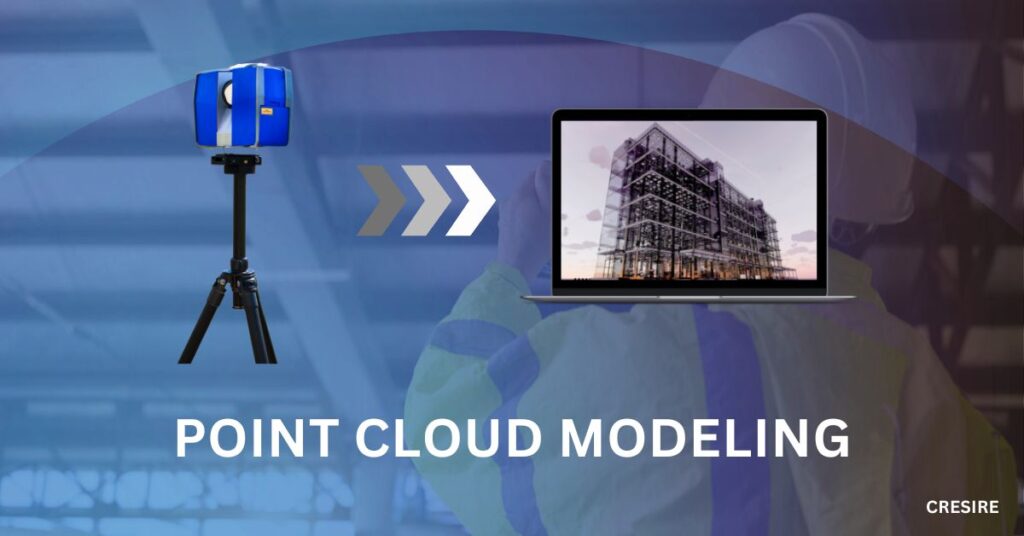In the fast-evolving world of architecture, engineering, and construction (AEC), Commercial Point Cloud Modeling is emerging as a transformative technology in the USA.
This advanced technique revolutionizes how professionals approach building design, renovation, and infrastructure management.
In this blog post, we’ll delve into Commercial Point Cloud Modeling, its benefits, and why it’s becoming a game-changer for commercial projects across the United States.
What is Commercial Point Cloud Modeling?
Commercial Point cloud modeling involves capturing the precise geometry of an object or space using 3D scanning technology. This data is then used to create detailed 3D models accurately representing the physical environment.
This means creating highly accurate digital replicas of buildings, infrastructure, and other structures for commercial projects.
The process begins with a 3D laser scanner or photogrammetry technology, which collects millions of data points from the physical environment.
These points, known as a “point cloud,” are then processed and converted into a detailed 3D model using specialized software.
Why Commercial Point Cloud Modeling is a Game-Changer
1. Enhanced Accuracy and Precision
One of the primary advantages of commercial point cloud modeling is its unparalleled accuracy. Traditional methods of manual measurements are prone to errors and can be time-consuming.
Point cloud technology, however, captures every detail with high precision, ensuring that the 3D model reflects the exact dimensions and conditions of the physical space.
This accuracy is crucial for commercial projects where even minor deviations can lead to costly errors and delays.
2. Streamlined Project Workflow
Point cloud modeling streamlines the workflow of commercial projects by providing a comprehensive and accurate base model.
This model is a valuable reference throughout the project lifecycle, from design and planning to construction and maintenance.
Architects, engineers, and contractors can collaborate more effectively by having a detailed and up-to-date model, reducing the likelihood of miscommunication and rework.
3. Improved Design and Visualization
With point cloud models, designers can create highly detailed and realistic visualizations of their projects. This capability enhances the design process by allowing stakeholders to visualize the outcome more accurately.
Whether it’s a new office building, a retail space, or an industrial facility, having a detailed 3D model helps make informed design decisions and present concepts to clients more compellingly.
4. Efficient Renovations and Retrofits
For renovation and retrofit projects, point cloud modeling offers significant advantages. Accurate 3D models of existing structures facilitate better planning and coordination.
By understanding the current conditions of a building, including hidden elements like structural beams or HVAC systems, contractors can develop more effective strategies for upgrades and modifications. This reduces surprises during construction and helps maintain project schedules and budgets.
5. Enhanced Facility Management
Once a commercial project is completed, the point cloud model remains a valuable asset for facility management. The 3D model can be used for ongoing maintenance, space planning, and future renovations.
Facility managers can access detailed information about the building’s infrastructure, leading to more efficient operations and management.
The Growing Adoption of Commerical Point Cloud Modeling in USA
In the USA, the adoption of commercial point cloud modeling technology is on the rise across various sectors. Here’s a look at how different industries are leveraging this technology:
1. Commercial Real Estate
In commercial real estate, point cloud modeling is used to create accurate as-built models of properties. This data is crucial for property management, leasing, and renovations.
Real estate professionals can present detailed 3D models to potential tenants or buyers, showcasing the property’s features and potential.
2. Healthcare and Education
Institutions in the healthcare and education sectors are increasingly adopting point cloud modeling for facility planning and management.
For example, hospitals and universities can use 3D models to design new buildings, plan renovations, and manage existing infrastructure more effectively.
3. Government and Infrastructure Projects
Government agencies and infrastructure projects benefit significantly from point cloud modeling. For large-scale projects such as bridges, highways, and public buildings, accurate 3D models help with planning, design, and construction. They also facilitate better management of infrastructure assets over time.
4. Manufacturing and Industrial
Point cloud modeling is used in the manufacturing and industrial sectors to create digital twins of factories and production lines. These models help optimize operations, plan maintenance, and design new equipment or processes.
Challenges and Considerations
While commercial point cloud modeling offers numerous benefits, it’s essential to be aware of some challenges and considerations:
1. High Initial Costs
The initial investment in 3D scanning equipment and software can be substantial. However, the long-term benefits of increased accuracy and efficiency often outweigh the initial costs.
2. Data Management
Handling large volumes of point cloud data can be challenging. Efficient data management practices and powerful computing resources are required to process and utilize the data effectively.
3. Skill Requirements
Creating and working with point cloud models requires specialized skills and training. Investing in skilled personnel or training existing staff is crucial for maximizing the benefits of this technology.
Future Trends in Point Cloud Modeling
Looking ahead, several trends are likely to shape the future of point cloud modeling:
1. Integration with BIM and GIS
The integration of point cloud data with Building Information Modeling (BIM) and Geographic Information Systems (GIS) will enhance the capabilities of these technologies. This integration will provide a more comprehensive view of projects and improve overall project management.
2. Advancements in Scanning Technology
Ongoing advancements in 3D scanning technology will lead to even higher accuracy and efficiency. Innovations such as handheld scanners and drones are expanding the applications of point cloud modeling.
3. Increased Automation and AI
Artificial intelligence (AI) and automation will play a significant role in processing and analyzing point cloud data. These technologies will streamline workflows and enhance the accuracy of 3D models.
Conclusion
Commercial point cloud modeling is reshaping the USA’s landscape of the AEC industry. This technology drives efficiency and innovation in building and infrastructure projects by providing enhanced accuracy, streamlined workflows, and improved design capabilities.
As adoption continues to grow and technology advances, point cloud modeling will undoubtedly play a crucial role in shaping the future of commercial construction and facility management.
For businesses looking to stay ahead in the competitive commercial real estate and construction sectors, embracing point cloud modeling is a step towards achieving greater precision and operational excellence.
To read more useful blogs, visit fantapa



